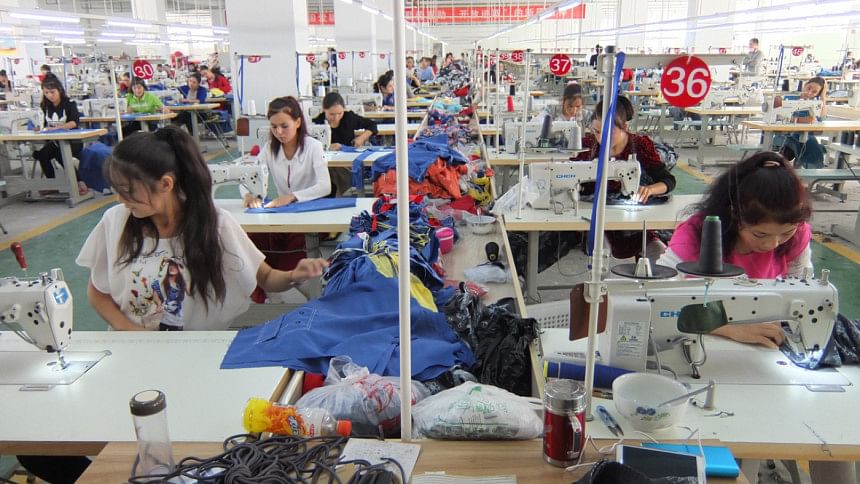Xinjiang: an emerging trade hub of China

CHINA'S north-western Xinjiang region, which had lagged behind other parts of the East Asian country for long, saw rapid economic development in the last few years.
China is now moving forward to materialise its vision of a New Silk Road for a better connectivity westwards through Central Asia, with Xinjiang as its core zone.
Gross domestic product of Xinjiang, the largest province in China, rose 10 percent year-on-year to 926.4 billion yuan (around $147 billion) in 2014, according to data from Xinjiang Commerce Department.
Per capita GDP soared to around $6,500 in 2014 from $6007 in the previous year.
The region's external trade went up to $27.67 billion last year with an annual growth rate of 19.6 percent between 2000 and 2004. Border trade accounted for more than half of the amount.
The province, which accounts for one-sixth of China's territory, now trades with 186 countries and regions, with Kazakhstan, Kyrgyzstan, Russia and Tajikistan being the major destinations.
Last year, its two-way trade with the four countries and Uzbekistan, Pakistan, Afghanistan, India, Turkmenistan and Turkey totalled $20.68 billion which made up around three-fourths of its entire foreign trade.
He Yiming, director general of Xinjiang commerce department, said the Chinese government was committed to making Xinjiang a regional transport hub and commercial, logistic and financial centre as part of its plan to turn the province into a core zone on the Silk Road Economic Belt.
Yiming was speaking at a seminar on the Silk Road Economic Belt in Urumqi, the capital of Xinjiang, early this month.

On the reason why Xinjiang had remained less developed than other parts of China, he said the areas that are close to sea develop quickly, and Xinjiang is far away from sea.
China has now turned its focus on land-based economy in line with the current development trend of the world, and linking the two ends of the country would ultimately help develop the areas in between, he added.
It was Chinese President Xi Jinping who first proposed building a Silk Road Economic Belt and 21st Century Maritime Silk Road, running through the continents of Asia, Europe and Africa, during his September-October visit to Central and South-East Asia in 2013.
The New Silk Road aims to connect China with Central Asia, Russia and Europe through Xinjiang, while the maritime route will run from China's coast to Europe and to South Pacific through South China Sea and the Indian Ocean.
Spurred by Jinping's “Belt and Road” initiatives, Xinjiang has taken up scores of projects to transform it into a hub of connectivity with its eight neighbouring countries, including Russia, Kazakhstan, Kyrgyzstan, Uzbekistan and Pakistan, as well as nations in Europe.
Urumqi Economic and Technological Development Zone (Toutunhe District), founded northwest of Xinjiang's capital in 1992 with an area of 280 square kilometres, has undertaken construction of five centres on the core area of the Silk Road Economic Belt. Those include transportation junction, commercial logistics, financial and cultural centres, and science, education and medical service centres.
The zone now has 588 registered key enterprises, 40 foreign investment enterprises and 14 listed companies.
It includes national export processing zone, high-speed rail hub, Swan Lake high-end business district, Xinjiang Software Park, Tianshan Cloud Computing Park, service outsourcing centre, international tourist centre, international textile and apparel trade centre and Railway International Logistics Park.
Around 1,500 kilometres southwest of this zone lies another important development area -- Kashi Economic Development Zone -- in Kashgar that is in close proximity to Kyrgyzstan, Tajikistan and Pakistan.
Covering an area of 50 square kilometres, this economic zone houses many manufacturing and assembling plants focusing on apparel, shoe, electronics and other goods.
Since 2012, the central and provincial governments have invested 15 billion yuan ($2.4 billion) for building infrastructure in this economic zone.
China also wants to turn Xinjiang into an oil, gas, coal and wind power production base, as the mineral-rich province's oil makes up 30 percent, gas 34 percent and coal 40 percent of China's total onshore reserves.
With an aim to make the best use of Xinjiang's geographical advantage, projects have been taken to build highways and railways, and install pipelines and information cables that will connect Central, West and South Asia and Europe to China's mainland.
In South Xinjiang, work is going on to build railways to connect China with Kyrgyzstan and Uzbekistan. China is also moving ahead with the construction of China-Pakistan railway and energy pipelines.

 For all latest news, follow The Daily Star's Google News channel.
For all latest news, follow The Daily Star's Google News channel. 



Comments